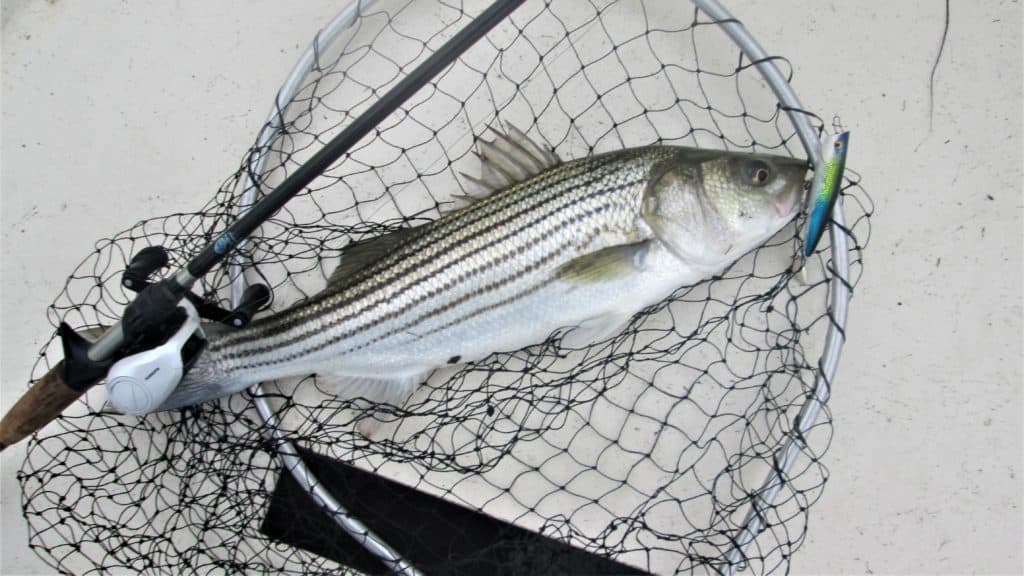Sporting Life

Top Water Bay Adventure
By Dennis Doyle
Sailing the shiny, new, 3/4 ounce plug well out from my skiff and about 5 feet off of a boulder rip-rapped shoreline, I paused, pointing the rod tip directly at the lure, now bobbing gently in the evening light. Counting off the seconds, when I got to 10 and could stand waiting no longer, I gave the lure just the slightest pop.
The rockfish must have been poised close by because at that moment it exploded on my lure, simply smashing it and turning the water into a white froth, definitely a major blow-up. Anyone who has had this experience knows how hard it is to control one’s reflexes at that moment and I was destined to be a prime example.
Planting my thumb hard on the spool and locking it in place, I unleashed a violent strike meant to plant the plug’s trebles deep into that bully’s mouth. Instead, I immediately had to drop down on one knee, ducking my head and wincing as the shiny, treble-hooked missile whistled back overhead, mere inches away.
Shaking as much from embarrassment at my poor performance as from my close escape from an emergency room hook removal, I sat down at the skiff’s helm and considered the error of my actions. Rule #1 when fishing top water lures for rockfish is simply this, never, never, never strike until you feel the actual pull of the fish on your line. Otherwise you will surely suffer a similar humiliation.
A striper can miss the hooks on a plug for many reasons, one of them being that it just smacked into the lure with its head instead of engulfing it, meaning to stun its prey and then leisurely eat it. It may have also passed by, intending to smash it with its powerful tail to the same effect. Or it may have inadvertently pushed the lure away in an eagerness of attack and lastly, it may just have missed it completely by a fortunate (for the fish) aiming error. Rock can be notoriously inaccurate.
The topwater bite usually begins on the Chesapeake toward early September. That’s when baitfish such as yearling perch and menhaden (alewife), spot, croaker and even bull minnows begin moving to the tributary mouths and the shallower flats, seeking more food and anticipating the fall.
The warm water conditions of a hot summer, however, keep most rockfish that feed on these youngsters, well out into the Bay’s deeper waters, at least until the sun finally sets and the rivers start cooling. An hour before dark is usually the soonest an angler will have a chance at intercepting a striped gamefish cruising the shallows but a heavily overcast afternoon may hasten the visitations.
The cooler temps of early dawn by comparison, do provide the superior window for a top water sortie. Again, an overcast morning can prolong their presence. And waiting for the pull of a fish at the blow up is just the first of a smart angler’s topwater strategies.
If the fish isn’t hooked up and you’ve managed to resist the urge to strike, the fish is still likely nearby, watching the lure and looking for signs of life. The slightest twitch on your lure at this point may set the predator off on another attack. Or it may not.
Waiting at least a 10-count then providing another twitch and then waiting again is the proper response. If nothing further happens, only then swim the plug back, vigorously and pausing from time to time to mimic a panicked and injured baitfish. If your plug still remains unmolested, try fishing the opposite quadrant on the other side of your boat in more open water for a few minutes.
Finally, cast back past where the blow up first occurred and work the plug actively, but slowly, through the same area one last time. Stripers can often respond aggressively again after just a short period of quiet and repose.
When your hands consistently continue to tremble long after the first blow up of an outing, you’re doing things just right. The proper angling focus for a top water adventure is one of anticipation and constant terror.
Fishfinder:
Though the current two-week suspension of the rockfish season (it reopens September 1) can be frustrating for some it should have a good result when the season resumes. Slacking off on fishing pressure may be just the trigger for the beginning of an improved fall season. September will bring top water action, increased activity by rockfish, action from Spanish mackerel, perhaps some bluefish and, most importantly, angler respite from the horrendous 100 degree weather. Trolling will locate the schools of the gamefish after the closure most efficiently and, once the schools have been found, will be far more receptive to jigging soft plastics, metal jigs and casting various types of lures. Chumming will resume nicely as will live lining. Crabbing continues to slowly improve and the fall feed up is on the way. What’s not to like?
